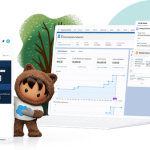Thanks to the rapid shift towards digital, the close relationship between company and customer has become king. Online shopping has quickly moved from the fringes to the centre of commerce.
This reality brings with it as many opportunities as it does challenges. Organisational success now comes from a combination of understanding customer expectations on the deepest possible level and choosing the best tools to meet them.
According to data from the fourth edition of the State of the Connected Customer report:
- Digital engagement spiked by 18% over the past year.
- Eighty percent of customers say that their experience of dealing with a company is just as important as the products or services they receive.
- Almost 60% of consumers expect to shop online more often in the future.
These statistics are just the tip of the iceberg. The popularity of online shopping is rising fast. That is why marketing, sales, and service teams are looking for any competitive edge that will improve the customer experience.
Here, we’ve broken down seven tips to help you get that edge. These include practical tips that you can act on as soon as you finish reading. We also share longer-term strategies that promise ongoing rewards. These tips, when implemented in combination, are a great way to improve every step of the customer journey.
1. Get to know your audience
We live in an age with plentiful access to customer data, even as the third-party cookie crumbles and privacy regulations tighten. However, that data is doing very little to benefit your business unless you use it in the right way.
The right way, in this case, is not only understanding the individual customer as intimately as possible. It’s also being able to group together similar individual customer profiles. You can use these to create audience segments and buying personas.
This is where CRM technology comes in. Salesforce Customer 360 offers a range of products, integrations, and add-ons. It allows you to arrange detailed pictures of your target audiences, enabling you to personalise your approach.
Whatever you want to achieve, Salesforce offers a selection of solutions to meet your needs.
2. Make your images work for you
Never underestimate the power of the image. We live in an increasingly visual world, where getting consumer attention is paramount. When online shopping, it’s easy for the attention of consumers to wander or get lost altogether, if the visual experience is sub-par.
By sub-par, we mean images of products that are underlit or overexposed, or look amateurish. Consumers crave the most enticing, dynamic, yet accurate representation of what they are looking to buy. If you have the budget, a 360-degree video of your product can boost sales even more.
Conversely, including images that are unrelated to the specific purchase can make your pages difficult to read.
In other words, images can make or break a sale. Implement them properly, and they’ll also help your site’s SEO ranking. Using images effectively requires thought and discernment, but if you get it right, your customers will appreciate the effort.
3. Show customers which products are most popular
The power of suggestion is always going to sway some consumers, but that’s not the only reason why popular products should be placed front and centre on your site. In almost all cases, products become popular for a reason, whether due to functionality, quality, or trends.
Your bestsellers are bestsellers for a reason. While new products are always enticing, never forget that customers are drawn to what others have purchased and endorsed.
Tableau for Salesforce Customer 360 allows different teams to gain a single view of customer data and act on the same insights. Amongst its many capabilities, one is the ability to bring together individual purchasing behaviours to get a real sense of product popularity. Tableau can help you present data in an easy-to-understand way, allowing every team to understand the insights. You can use this data to present popular products to different target audiences, offering deeper personalisation and greater ROI.
4. Remarket now and close more business
In the past, post-engagement retargeting had been quite clunky and, in some cases, off-putting to the consumer. Think of how annoying it is to receive ads for the exact product that you purchased a month ago. It’s also frustrating to get ads after accidentally clicking a link and closing it.
The good news is, this complicated process can be refined.
By using Marketing Cloud, you can track customers who’ve made a purchase, those who demonstrated interest but didn’t buy, and those who have been browsing elsewhere for similar products that you offer. You can then remarket to those individuals based on their personalised online shopping journeys. This minimises wasted ad spend and gives the customer what they want.
You can also take this flexibility further into real time with Marketing Cloud add-ons such as Interaction Studio.
5. Simplify the checkout process
The importance of the checkout process during an online transaction is often underestimated. Friction during the path to pay can easily lead to cart abandonment, and therefore a missed opportunity for customer loyalty.
Fortunately, the antidote to this undesirable result is: keep it simple. The customer shouldn’t have to wade through multiple lengthy pages to pay for what they want (particularly in the case of returning customers). Most people are time-pressed, and want to make a quick, safe, and hassle-free purchase.
You should also be clear about the extra information customers want, such as shipping costs and return policies.
Commerce Cloud is a sure-fire way to help you with all of the above.
6. Keep in touch with follow-up emails
Fact: a simple follow-up email can turn a one-time buyer into a loyal customer.
Chances are, if an individual has appreciated both the purchase and the experience, they’re far more likely to come back for more. Marketing Cloud can facilitate these kinds of meaningful interactions. You can send review requests, similar product recommendations, or maybe an inventive marketing campaign targeted to their preferences.
With the deep customer data that you have in your CRM, you can make each follow-up communication relevant to the individual customer. In this day and age of broken funnels and tangled pipelines, these benefits are priceless.
7. Do it all with consistency in mind
Tending to one or all of these individual aspects of the customer experience will be beneficial to an extent. The more you consider how each improvement relates to each other, the bigger the reward.
Consistency across channels and platforms is key. That’s because consumers use multiple channels to shop online, and they expect continuity across them all.
Products such as Commerce Cloud allow you to grab the attention of more customers and create a seamless omnichannel customer journey. One that stretches across marketing, sales, commerce, fulfillment, service, and beyond.
Salesforce has a range of tools to empower you to put your customer at the centre of everything you do.




























